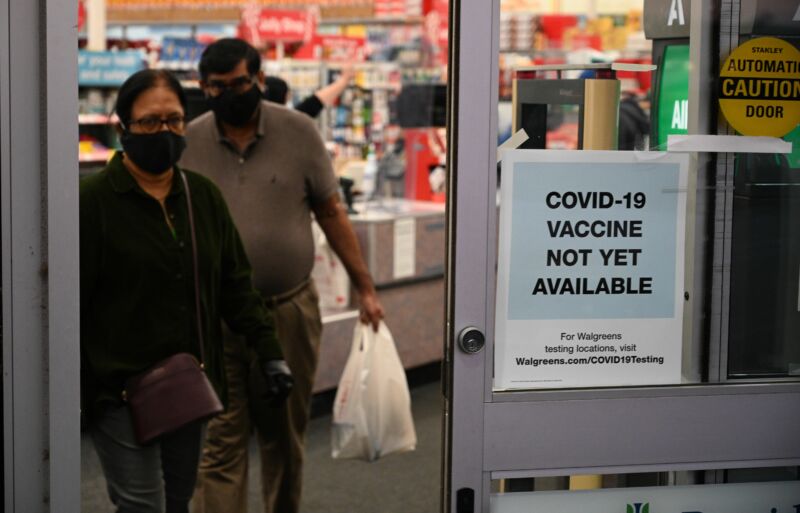
Individual states will ultimately decide who will get the first 6.4 million doses of COVID-19 vaccine, which will be distributed based on each state’s population rather than the levels of disease spread or number of high-risk people.
The approach, announced in a press briefing Tuesday, is a departure from earlier plans and reflects the frenzied effort to vaccinate a country of nearly 330 million as quickly as possible.
Top officials for Operation Warp Speed—the federal government’s program to swiftly develop and deliver COVID-19 vaccines and therapies—said at the briefing that the current approach is intended to “keep this simple.” However, the potential for state-by-state variation in early access to vaccines could easily become complicated—and time is ticking for states to get their distribution plans clarified. There’s just a matter of weeks before the Food and Drug Administration may grant an emergency authorization for a vaccine by Pfizer and BioNTech.
Last week, Pfizer and BioNTech announced that their mRNA vaccine was 95-percent effective at preventing symptomatic COVID-19 in their 43,000-participant clinical trial—and on Friday the companies submitted a request to the FDA for an Emergency Use Authorization (EUA). The FDA is reviewing the request now and will hold a public meeting with their Vaccines and Related Biological Products Advisory Committee on December 10 to discuss the potential authorization.
Federal and state officials, the companies, and private partners are all working under the expectation that the FDA will grant that authorization. If it does, the federal government plans to begin distribution of the vaccine within 24 hours of the EUA call. The challenge now is to figure out how to dole out that initial supply—among and within states.
Distribution recommendations
There are numerous bodies of experts who have released recommendations and guidance for distributing COVID-19 vaccines, including expert panels for the National Academies of Medicine and the World Health Organization. But the panel that has traditionally been tasked with this role—and the one that has made vaccine policy recommendations for decades—is the Advisory Committee on Immunization Practices (ACIP), a panel based out of the Centers for Disease Control and Prevention.
In broad strokes, all the expert panels recommend vaccine distribution start with the highest-risk groups, including frontline health care workers, the elderly, and nursing home residents. But the initial batch of 6.4 million vaccine doses—if the Pfizer/BioNTech vaccine gets an EUA—won’t be enough to cover even those select high-risk groups, creating the need for more detailed prioritization plans.
ACIP has broadly suggested that allocation to states be based on the high-risk groups within them. In a meeting Monday, the panel laid out the framework of principals that will guide their specific prioritization recommendations for high-risk groups. However, ACIP isn’t planning to finalize those recommendations until after the FDA actually grants the EUA.
Operation Warp Speed officials had previously suggested they would wait for the ACIP recommendations before making the call on state allocations and prioritization recommendations. But that apparently changed late last Friday night.
“We hit the button at 11:35pm,” Gen. Gustave Perna, head of logistics for Operation Warp Speed, said at the press briefing Tuesday. “I finally made the decision Friday night—late Friday night—to snap the chalk line so states could prioritize based on [the] amount” of vaccine that has been allocated to them, which was based on population size.
State of things
Once those per-capita-bases allotments arrive, states will have to decide on their own how to divvy up the initial doses among people in the highest-priority groups.
It’s up to the federal government to set recommendations for prioritization, Secretary of Health and Human Services Alex Azar said at the briefing, but “it will be [up to] our nation’s governors in implementing the distribution plans to tell us… where to ship [vaccine doses], and they will decide whom the vaccine is given to. We hope that our recommendations will carry weight with them, but at the end of the day, they will make that decision.”
Azar went on to note that Operation Warp Speed is not waiting for the finalized ACIP prioritization recommendations to make their own guidance for states. They’re taking in recommendations from all the panels and the ACIP’s initial recommendations, he said.
“We are working expeditiously to formulate our recommended prioritization for vaccine distribution based on where we can secure the maximum effect under whatever the current epidemiological circumstances are in the United States at that time,” Azar said.
Though some states have already signaled that they will distribute vaccines according to the ACIP's final guidance, Azar noted that vaccine allotments for each state will continue to be on a per capita basis, rather than risk. He stressed that this was intended to keep things simple and consistent.
Apart from the question of who will get vaccinated, Pfizer is busy working out the question of how. The company has been conducting “dry runs” of vaccine delivery and rehearsing with vaccine distributors how to unpack, store, and handle the vaccine doses once they arrive. In first practices, distributors have shown some “initial hesitation,” Perna said, but they have grown more comfortable with the protocols and helped Pfizer refine training methods.
The Pfizer/BioNTech vaccine's distribution has been a point of concern given that it requires ultra-cold storage conditions of -70 degrees Celsius. But, Pfizer has worked to alleviate concern, emphasizing its cold-chain infrastructure already in place and its shipping containers that have GPS-enabled thermal sensors to track the location and temperature. Currently, the dry runs for vaccine distribution have not included the dry ice needed to maintain the extreme storage temperature during shipping. But, according to The Washington Post, Pfizer will begin test shipments that include dry ice in the coming weeks.
reader comments
160